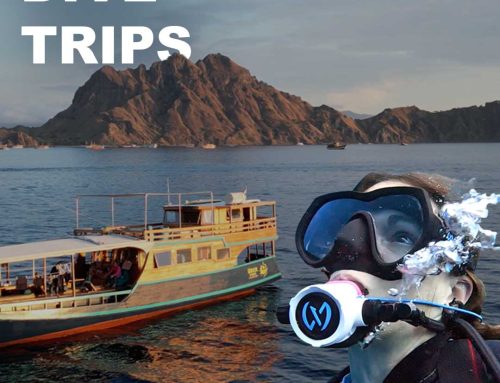Be prepared for your next boat trip
A few people in my Patreon community didn’t know what a negative entry was, so I figured a review of all deep-water entries would be helpful to everyone. Also, if you’re looking for deep-water entries specific to sidemount, check out this video.
No equipment
By no equipment, I mean jumping in with only mask and fins. Once you get in the water, the boat team or your buddy can pass you the rest of your equipment. Then, you put everything on in the water. An important note about this is to always make sure you have your BCD on when wearing your weight belt. That means, you put on your BCD first, then take your weight belt from the boat or dock. This entry is perfect for people who shouldn’t be carrying the weight of their scuba equipment outside of the water. However, this style of deep water entry doesn’t work if there is a strong surface current.
Giant stride
The giant stride is best when diving from a dock or boat with standing room at the sides. This is the best water entry to choose if the boat is tall. Add some air to your BCD and have everything in its place, meaning mask on and regulator in your mouth. You’ll see experienced divers jump in without their mask or regulator in place, but if you’re starting out, set yourself up for success and comfort by being fully prepared to hit the water. The best hand position is right hand over your mask and regulator to keep them in place and left hand on your weight belt or other accessories.
One thing I see with the giant stride is people try to leap off the boat. Although that’s totally fine to do, you don’t have to stress about jumping. The giant stride is exactly what it says it is. A big step off the boat.
Back roll
The back roll is great for small boats where you have a ledge to sit on. Confirm that no one is in the water below you before you let go. This goes for all deep-water entries, but is particularly important with the back roll because you don’t have direct eye contact with the water before you enter.
Have everything in place, some air in your BCD, and lean into the boat while sitting on the edge to avoid accidentally fall into the water early. Hand placement will be right hand over mask and regulator and left hand on accessories or over the mask strap at the back of your head.
You will probably do this entry in sync with the other divers on board, so it’s important to discuss timing with the dive team.
If you do miss the countdown, just wait. The last thing you want to do is jump late and knock somebody in the face with your tank.
Trust fall
The trust fall is a less common deep-water entry, and is mostly done for funzies. This is best done from a place not far from the surface, so floating docks or a boat with a lowered dive platform work well. As indicated in the name, you stand at the edge of the platform facing away from the water and fall back with a splash. Use the same equipment rules and hand placement as in the giant stride or back roll.
Flip
The forward flip off the boat into the water is dumb.
Cool guy divers do it, and I’m not a fan. I’ve seen people face plant trying to learn it, and you have a higher chance of losing pieces of your gear by flipping into the water. Don’t get me wrong, you can do it, and maybe it’s fun for you, but I don’t think it’s a good idea to teach people to show off like this.

Now let’s get to the fun stuff… negative entry
The negative entry is a very useful deep-water entry to practice and have in your diving repertoire. This entry is used when diving in a strong current without a line.
Unlike the other entries, you want to have a completely empty BCD. That means before jumping in, open your dump valve and squeeze all the air out of your equipment. Some people will suck the air out of their BCD, but I don’t recommend that because you don’t know what kind of nasty mold could be living in your equipment, especially if your stuff is old and you haven’t always been the best about rinsing and drying it out completely…
When diving in a strong current, it’s a good idea to take some extra weight to help with a quick descent.
Once you’re in the water…
Depending on the kind of entry (giant stride or back roll) you’ll want to be quick about getting in the water. With the back roll, you’ll get everyone (or mostly everyone) in the water at the same and start the descent together. When doing the giant stride, you must be quick about jumping after the person in front of you. Obviously you don’t want to jump on top of them, but if the current is strong, this shouldn’t be an issue. In this entry, you need everything in place and ready to dive, meaning mask defogged and all accessories attached. You can have your hand on your dump valve when you hit the water (making sure you choose the correct one for your body position) in the case of air still trapped in the BCD. Then, you get upside down and start swimming, following your guide, compass headings, or natural references.
You need a quick descent here, so if you struggle with equalizing, you may be left behind to rejoin the boat at the surface. The dive operator protocols will depend on the location, but this is an advanced skill where you are expected to be self-sufficient enough to either keep up with the team, or end the dive on your own.
That sounds scarier than it actually is. If you can’t keep up, you slowly return to the surface. I recommend people take their octopus and send up some blasts of bubbles to let the boat know that someone is coming up.
You should have a surface marker buoy (and I say should because I’ve seen dive operators not offer this to clients as part of their rental gear), but you can deploy it once you get to the surface. Depending on how strong the current is, you may not want to deploy it underwater.
Future Azul Unlimited dive expeditions
If you want to join me on my next trip, sign up for Patreon (and get trip discounts) or my email list for first dibs on boat spots.








